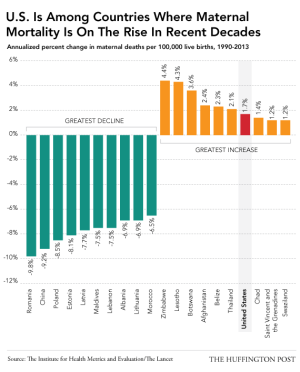
The Maternal Mortality Epidemic: The Policy Created Health Emergency Happening Under Our Noses

by Bill Lambert, Pro-Choice Houston
Few get misty eyed reflecting on the Bush Sr. presidency, but from a maternal mortality standpoint it’s worth a review. Those were years of historic lows in childbirth related death due largely to common sense policies and health spending levels introduced before Bush Sr’s tenure. As a nation we prioritized the health of our most vulnerable citizens and achieved something to brag about. Since those lows, maternal mortality nationwide has more than doubled, and women of color and/or in poverty are dying at a disproportionate and growing rate. A recent UN report entitled REPRODUCTIVE INJUSTICE: RACIAL AND GENDER DISCRIMINATION IN U.S. HEALTH CARE details what it describes as a Human Rights Crisis in our own backyard:
“Maternal mortality is a human rights crisis in the United States. Between 1990 and 2025, as the overwhelming majority of countries dramatically reduced the incidence of maternal mortality, the maternal mortality ratio in the U.S. more than doubled from 12 to 28 maternal deaths out of every 100,000 live births. Racial disparities fuel this crisis. For the last four decades, Black women have been dying in childbirth at a rate three to four times their White counterparts. Cities and states with a high African American population also have the highest rates of maternal mortality in the country; in some areas of Mississippi, for example, the rate of maternal death for women of color exceeds that of Sub-Saharan Africa.”
UN Committee on the Elimination of Racial Discrimination
How did we get from the lows in maternal mortality at the end of the 1980’s to this human rights crisis? Health factors including obesity and diabetes play a role, the overuse of Cesarean Sections on the part of the birthing industry is a factor as well, but these alone can’t explain a nationwide doubling of maternal mortality rates.

But isn’t this a bit like the police policing themselves? Isn’t the rush to slash health spending a factor? Can the the Joan Huffman task force be critical of anti-choice policies designed to (1) deny women their bodily autonomy, (2) MANDATE THAT DELIBERATE MISINFORMATION be given to patients, (3) public funding of anti-abortion counseling centers disguised as clinics, and (4) abstinence-only educational programming? How much of the crisis of maternal mortality has been created via policy? The states where anti-abortion legislation has been most rampant and women’s health spending fleeced the most ARE the states with the “worst health outcomes for women and children”:
For example, Oklahoma has the maximum number of abortion restrictions (14 in total) and has some of the country’s worst outcomes for women’s health – including higher maternal mortality rates, higher uninsured rates, and lower rates of cancer screening, among other outcomes – and some of the worst outcomes for children’s health – including higher infant and child mortality rates, lower rates of preventive care, and higher rates of teen alcohol and drug abuse, among other indicators.
Politicians in states like Texas and Louisiana have made the claim that restrictions on abortion services protect women’s health and safety, despite the fact that leading medical associations—including the American Medical Association and the American College of Obstetricians and Gynecologist—oppose such restrictions precisely because they are a threat to women’s health, lives, and well-being.” -
Evaluating Priorities: Measuring Women and Children’s Health and Well-Being Against Abortion Restrictions in the States, by the Center for Reproductive Rights and Ibis Reproductive Health.
And for women of color and the working poor, the numbers only get worse. The UN report lists these factors stacking the deck against pregnant Black and immigrant women:
- lack of information about sexuality and sexual health;
- discrimination in the healthcare system;
- lack of access to sexual and reproductive health care; and
- poor quality of sexual and reproductive health information and services.
However, pregnant women in Texas are more likely to find misinformation and outright lies from state funded crisis pregnancy centers. Access to Women’s health services has been infringed upon by legislation arbitrarily closing facilities. In upholding the law (HB2) designed to shut down all but seven Texas abortion clinics, the Fifth Circuit Court decided the lower U.S. District Court had erred in allowing for “evaluating whether the ambulatory surgical center provision would actually improve women’s health and safety.” [Ed. Note: This law appears to have been struck down by the US Supreme Court in the time since this article was written.]
Women’s lives and livelihoods are being jeopardized for short term political gain. This is a man-made disaster playing out around us with no political will to address it in an honest way. Shouldn’t the common sense funding of Women’s Health during Daddy Bush’s era be our guidepost? before all the unnecessary legislation driven by politics to deny women reproductive health access? We got there before. We know how. We just need leadership with the political will to fight for us instead of against us, but that leadership has yet to show itself.
The UN Committee offers some recommendations:
Eliminating disparities in reproductive health care, including maternal mortality, will require proactive steps by the U.S. government to: increase both general and pregnancy related coverage of uninsured women; improve access to contraceptive services and maternal health care; train healthcare providers to avoid racial stereotypes and provide high quality care to all women; ensure comprehensive sexuality education and information; and provide adequate social supports for recent parents, including paid parental leave. In addition, the U.S. should strengthen monitoring and accountability measures for maternal mortality in line with human rights standards.
But the leadership that can see this through has to be built.


You must be logged in to post a comment Login